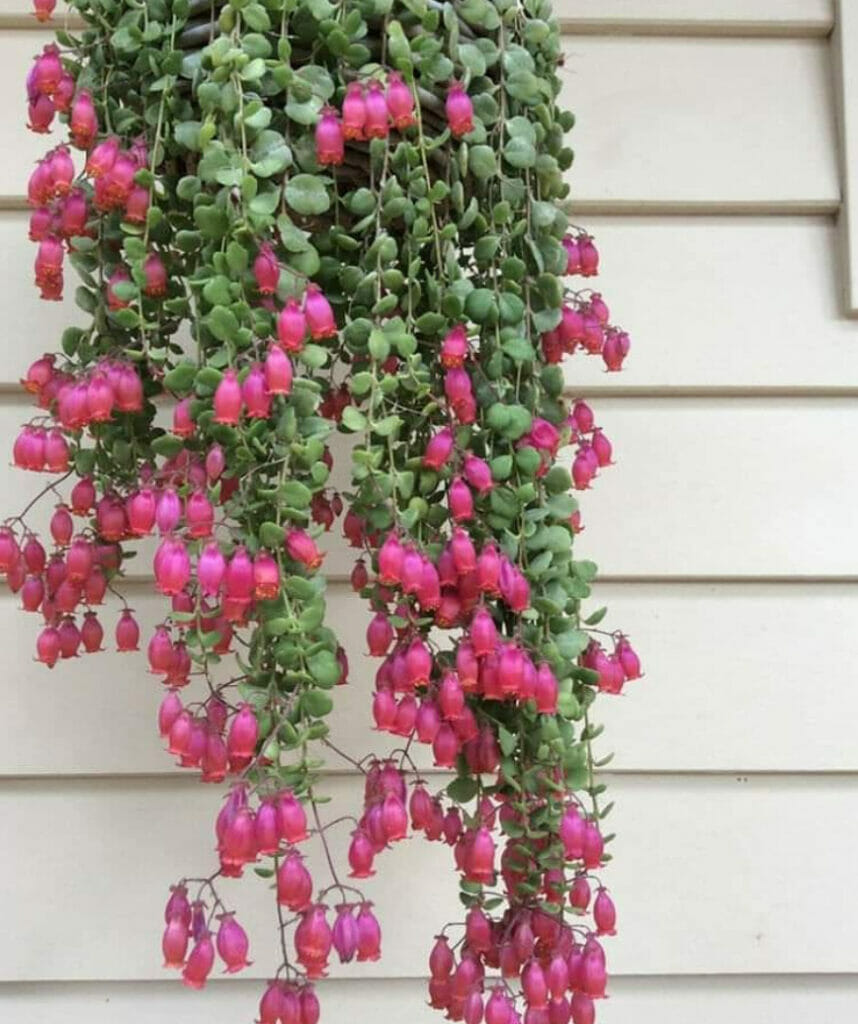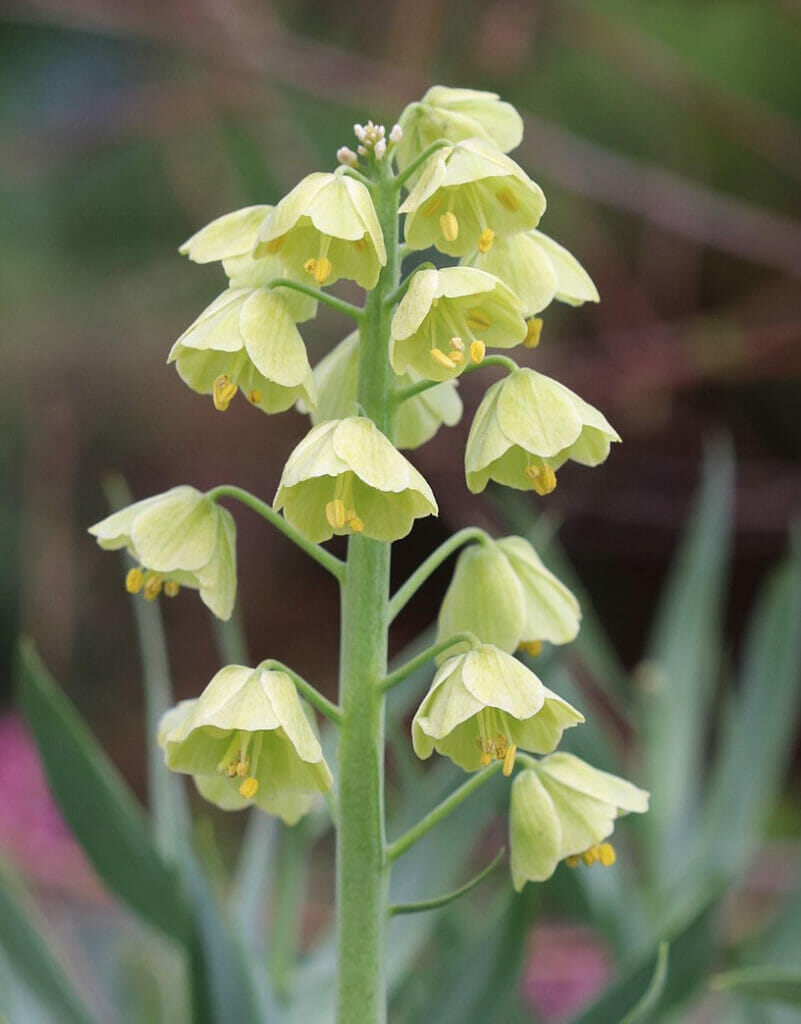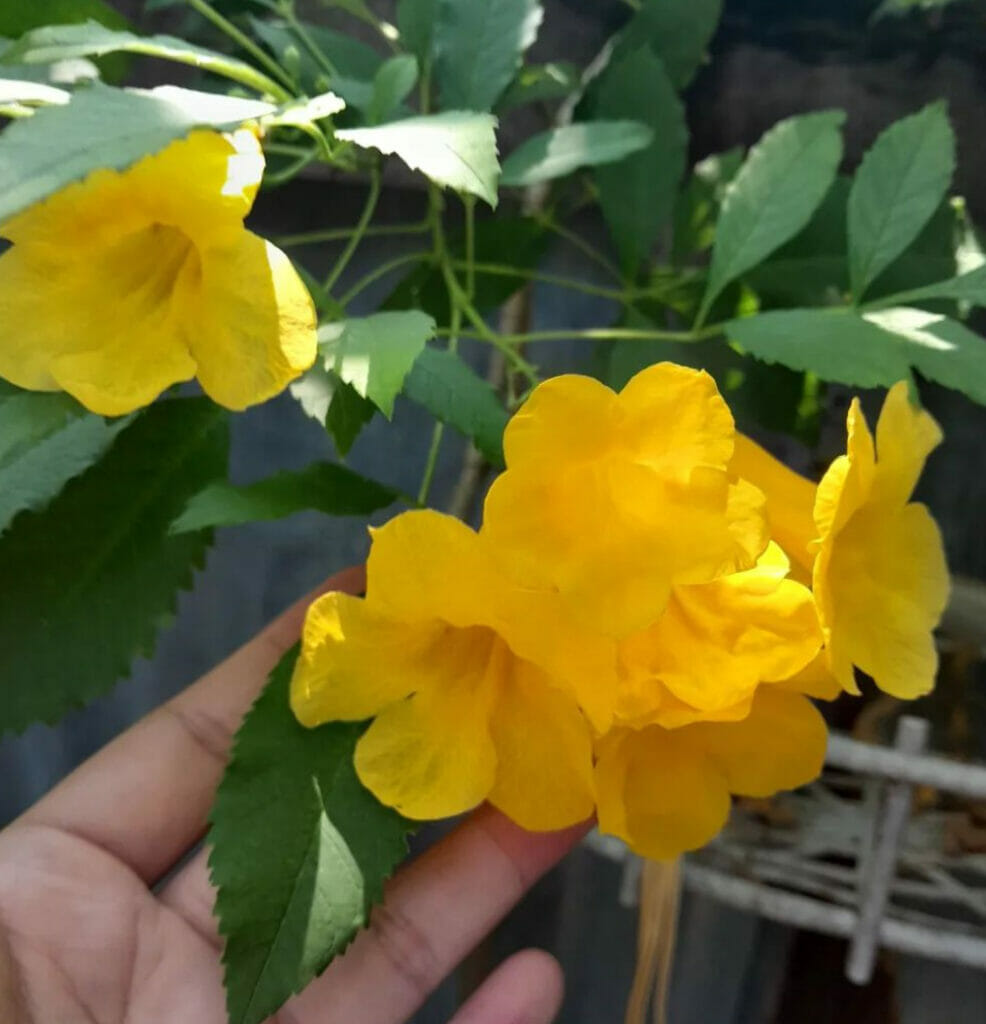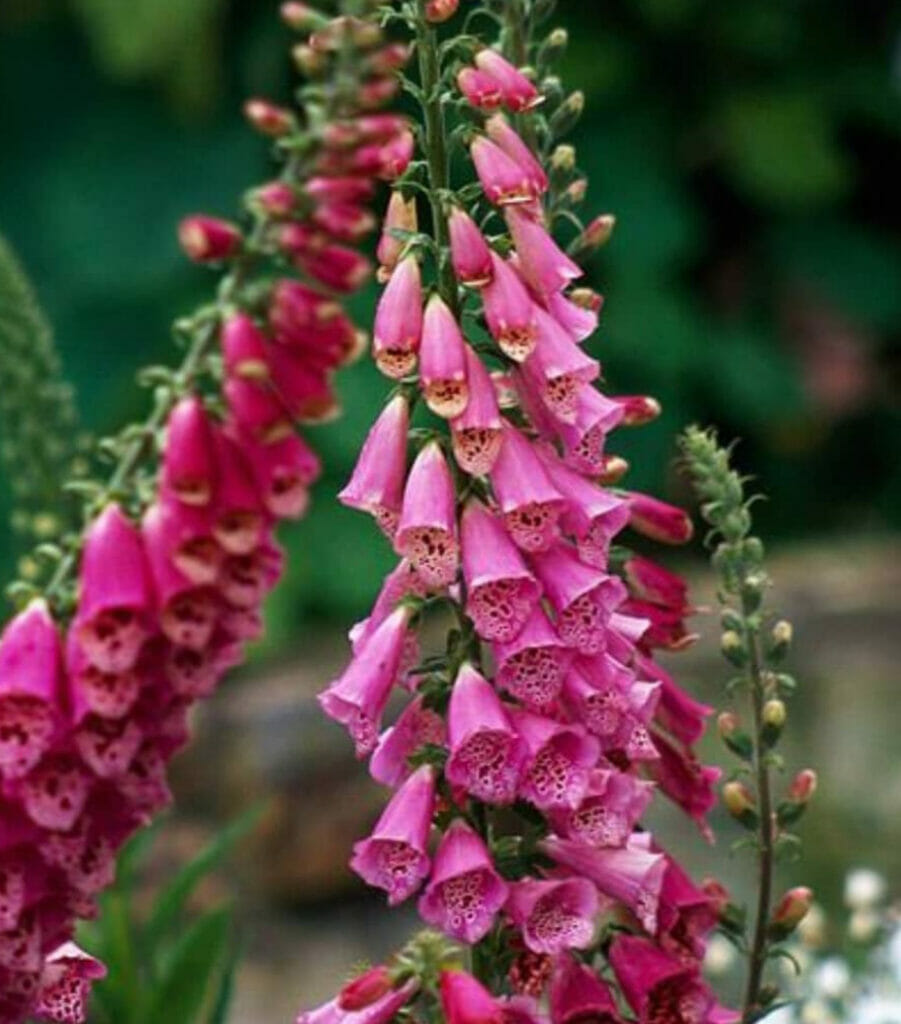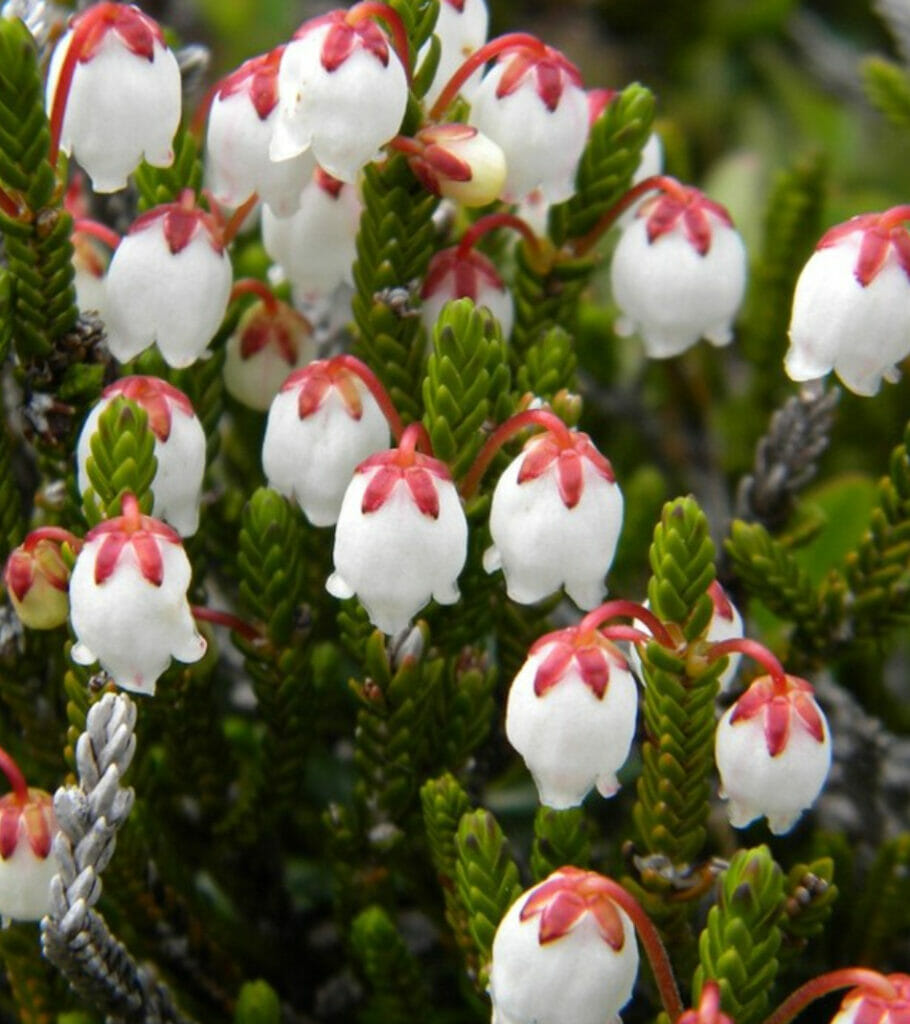Best Bell-Shaped Flowers to Add to Your Garden
Bell Shaped Flowers is undoubtedly an attractive addition to any garden. Their color and mesmerizing shape are enough to add life and beauty to a place. Not only are they appealing, but they are extremely low maintenance too. In this article, we are going to explore 41 plants with flowers that look like bells. You can add these plants to brighten your garden.

41 Beautiful Flowers That Look Like Bells
Following are some of the best bell-shaped flowers that are a must-have in your garden.
1. Coral Bells (Heuchera sanguinea)
Common Name: Coral Bells, Fairy Flowers
Flower: Red
Flowering Season: Spring/ Summer
USDA Hardiness: 4-9
Size: 1-2 feet
Coral Bells is a perennial plant that blooms delicate and tiny flowers in the shades of red, pink, and white in spring and summer. When this plant is grown with its companion plants like ferns hostas, it instantly adds beauty to the area tenfold. The most popular place to plant coral bells is in landscapes. As coral bells are adaptable to various exposures, it is easy to grow it in any environment.
2. Morning Glory (Ipomoea purpurea)
Common Name: Morning Glory
Flower: Pink, Purple, Blue, White
Flowering Season: Summer
USDA Hardiness: 9-11
Size: 6-10 feet
This plant consists of purple saucer-shaped and exotic-looking blooms, which are also available in white, blue, and pink colors. It is best for gardens that need some touch of vines as Morning Glory is an annual vining plant. Due to its vining nature, it can easily climb up on fences and trellises. However, it can also be planted indoors as a container plant because of its low maintenance.
3. Bluebells (Hyacinthoides non-scripta)
Common Name: Bluebells, English Bluebells
Flower: Purplish-blue
Flowering Season: Sping
USDA Hardiness: 4-9
Size: 1-2 feet
Bluebells are popular wildflower bulbs native to Europe and North America. As the blue or purplish-blue flowers droop downward on tall stems, they attract a lot of attention from people who love having stunning flowering plants. The plant blooms in spring and immediately fills the environment with its immaculate beauty.
4. Daffodil (Narcissus pseudonarcissus)
Common Name: Daffodils
Flower: Yellow, White, Orange
Flowering Season: Spring
USDA Hardiness: 5-9
Size: 16 inches

This bulbous perennial plant is popular for its yellow, white, and orange flowers with star-shaped petals. Its flowers are actually a sign of the upcoming spring. The flowers have a tendency to bloom each spring every year, so it is best to plant them in woods and along the streams where they can grow naturally. To make the best of this plant, bloom it in autumn before the first snow and give it water regularly. The plant will grow fast and bloom in no time.
5. Mini Angel Trumpet (lochroma australe)
Common Name: Mini Angel Trumpet
Flower: Blue, Pink, Purple, Red
Flowering Season: Summer
USDA Hardiness: 9-11
Size: 3-5 feet
Native to South America, this beautiful flowering plant is known for its trumpet-shaped flowers which grow in clusters. The flowers bloom in shades of purple, blue, pink, and red. Mini Angel Trumpet has a shrubby growth and can easily grow up to 4-5 feet in length and width. It is important to note that this plant is toxic if ingested, so keep it out of reach of children and pets.
6. Bellflower Beardtongue (Penstemon campanulatus)
Common Name: Bellflower Beardtongue
Flower: Blue, Purple Pink
Flowering Season: Late spring to Early summer
USDA Hardiness: 8-10
Size: 32 inches
Bellflower Beardtongue is a semi-evergreen perennial plant that can grow up to 32 inches in height. Its stunning flowers that look like bells are a great attraction for gardeners. These flowers are available in blue, purple, and pink colors. This plant is mostly known for its extreme hardy nature and can tolerate cold temperatures too. One of the best things about this plant is that it can grow anywhere, including in the cracks of rocks.
7. Peach-leaved Bellflower (Campanula persicifolia)
Common Name: Peach leaved bellflower
Flower: Pink, Blue
Flowering Season: Early to Mid Summer
USDA Hardiness: 3-7
Size: 12-40 inches
It is a perennial deciduous shrub with attractive blooms which come out in early to mid-spring. The flowers that look like bells start shedding as soon as autumn approaches after turning yellow. With good care, this plant can reach 40 inches in height. The best way to grow this plant is by giving it moist but well-draining soil and partial shade. Because of its low maintenance needs, it is a popular choice for gardeners to have.
8. Persian Lily (Fritillaria persica)
Common Name: Persian Lily
Flower: Purple, Pink, Yellow
Flowering Season: Mid to Late Spring
USDA Hardiness: 4-8
Size: Up to 60cm
If you need a unique and exotic look for your garden, Persian Lily is the best choice. The stunning flowers that look like bells grow on upright stems. Gardeners and landscape experts love growing Persian Lily because of its flowers which bloom in green, ivory, deep red, and deep purple color. It blooms in late spring and easily grows up to 60 cm tall.
9. Trumpet Vine (Campsis Radicans)
Common Name: Trumpet Vine, Trumpet Climber, cow itch vine, Hummingbird vine
Flower: Red, Orange
Flowering Season: Summer, Autumn
USDA Hardiness: 4-9
Size: 12m
This flowering deciduous woody plant is a climbing vine known for its beautiful trumpet flowers that look like bells. Trumpet Vine can grow up to 1 meter and is best for growing against a wall or trellis. It has an extensive root system, which enables the plant to grow fast. The flowers of trumpet vine grow in autumn and attract hummingbirds and bees for pollination. It can grow in a variety of conditions, including full sun to partial shade. Moreover, it is also drought tolerant.
10. Foxglove (Digitalis purpurea)
Common Name: Foxglove
Flower: Pink, Purple, White
Flowering Season: Summer
USDA Hardiness: 4-9
Size: 6 feet
Native to Western and Southwestern Europe, this flowering plant produces spikes of bell-shaped flowers in purple, pink, and blue color. The flowers are beautifully arranged in tall spikes and can reach up to 6 feet. Foxglove has a biennial life cycle which means that it produces leaves the first year, blooms the second year, and then dies in the third year. This plant is best for ornamental purposes and has also been used for medicinal purposes in the past. However, it is toxic to animals and humans if ingested directly.
11.Lantern Tree(Crinodendron hookerianum)
Common Name: Chilean Lantern tree/Chilean Firebush
Flower: Red, Orange
Flowering Season: Summer, Autumn
USDA Hardiness: 9-11
Size: 5-10 feet
It is an evergreen shrub, which is popular for its bright red lantern-shaped leaves. The flowers are beautifully displayed on long stalks among tiny and narrow leaves, which makes the plant visually pleasing. This plant loves a moderate climate where it needs full sun to partial shade and well-draining soil. Its flowers are fragrant, which are a great source for attracting hummingbirds and other pollinators.
12. Snowdrops (Galanthus)
Common Name: Snowdrops
Flower: White
Flowering Season: Winter
USDA Hardiness: 3-7
Size: 3-4 inches
Native to Europe and the Middle East, Snowdrops is a bulbous perennial plant whose appearance resembles snow falling on the ground. The flowers bloom in January and February and have a sweet smell. As this plant is one of the first to bloom, it is an early source of food for pollinators. Snowdrops are usually used in cut flower arrangements but can also be used as a decorative plant indoors because of its hardiness.
13. Lily of the Valley (Convallaria majalis)
Common Name: Lily of the Valley, Lady’s Tears, Mary Bells, Mary’s Tears
Flower: White, Pink
Flowering Season: Early to Mid spring
USDA Hardiness: 3-9
Size: 8-12 inches
Lily of the Valley is known for its stunning white flowers that look like bells. These flowers dangle from the tiny stems. Contrary to what its name suggests, this plant isn’t actually a lily but belongs to the Asparagus family. It is a shade-loving plant that thrives in full to partial shade. This means that it is best to be planted in shade gardens and woodlands. This plant is toxic to ingest, so keep it away from pets and children.
14. Grape Hyacinth (Muscari)
Common Name: Grape Hyacinth
Flower: Blue, Purple, Pink, White
Flowering Season: Spring
USDA Hardiness: 3-9
Size: 4-8 inches
The beautiful purple and green contrast of this plant is enough to add life to any garden. Its purplish-blue blooms resemble clusters of grapes, making it a popular choice for gardeners all around the world. Apart from purple, this plant also blooms in white, pink, and blue colors. It is a great companion plant to daffodils too. The best time to plant Grape Hyacinth is in the fall so it can be ready for bloom in spring.
15. Mountain Laurel (Kalmia latifolia)
Common Name: Mountain Laurel
Flower: Pink, White, Red
Flowering Season: Late Spring to Early summer
USDA Hardiness: 5-9
Size: 3-4 feet
It is an evergreen shrub that produces clusters of beautiful red, pink, or white flowers in the shape of saucers. These flowers usually bloom in late spring to early summer and attract plant lovers. Mountain Laurel is a low-maintenance plant that grows well in well-draining soil. When the plant is young, it needs adequate water to grow, but once matures, natural rainfalls are enough to fulfill its water needs.
16. Bells of Ireland (Moluccella laevis)
Common Name: Bells of Ireland, Shell Flowers
Flower: Green
Flowering Season: Summer and Early Autumn
USDA Hardiness: 2-9
Size: 4 feet
A unique-looking plant mostly used for flower arrangements, Bells of Ireland is an annual shrub that can reach up to 4 feet. The flowers that look like bells are actually white in color, which grows inside the green calyxes that people think of as actual flowers. The flower has a sweet aroma which attracts different pollinators.
17. Cowberry (Vaccinium vitis-idaea)
Common Name: Foxberry, cowberry, Lingonberry
Flower: White, Pink
Flowering Season: Spring
USDA Hardiness: 3-8
Size: 5-30cm
This plant produces white to pink, tiny bell-shaped flowers, and the plant has a shrubby growth. Cowberry produces juicy berries in the summer, which are edible and a great source of Vitamin C. However, the leaves of this plant are toxic. It is a deciduous plant that forms underground stem-forming colonies. Other names for this plant are lingonberry and foxberry.
18. Guinea Hen Flowers (Fritillaria meleagris)
Common Name: Guinea Hen Flowers, Snake’s Head Fritillary
Flower: Purple, White
Flowering Season: Spring
USDA Hardiness: 3-8
Size: 10-12 inches
Also known as Snake Head’s Fritillary, this plant is known for its flowers which have checkered patterns on them and hang from the stems in the form of clusters. The flowers are found in white and purple color. It is an ornamental plant that is best for having in houses in the spring season.
19. Penstemon “Windsor Red” (Penstemon barbatus.)
Common Name: Penstemon Red
Flower: Red
Flowering Season: Early to Late Summer
USDA Hardiness: 3-8
Size: 16-18 inches
This semi-evergreen has bright red trumpet-shaped flowers with flecks of white inside their petals. The flowers look beautiful on tall stems and make this plant a popular choice for gardeners. It is a hardy plant, which means it can adjust to every type of climate. Its flowers are a great attraction for many pollinators.
20. Trumpet Honeysuckle (Lonicera sempervirens)
Common Name: Trumpet honeysuckle
Flower: Red, Orange
Flowering Season: Late Spring to Early Summer
USDA Hardiness: 5-9
Size: Up to 30 feet
This plant is known for its long tubular flowers which are found in red and orange color. It is a deciduous flowering plant that is often found in the United States. Trumpet Honeysuckle is a fast-growing vine, reaching up to the height of 30m. Its flowers are a great source of attracting different pollinators.
21. Creeping Bellflower (Campanula rapunculoides)
Common Name: Creeping Bellflower, Campanula, Rover Bellflower
Flower: Purple
Flowering Season: Late Spring to Early Summer
USDA Hardiness: 3-9
Size: 1-3 feet
It is a perennial plant that has a creeping growth habit. The plant grows purple or blue trumpet-shaped flowers which often bloom between late spring to early summer. As the plant has a vining growth, it is considered best for ground covers. This plant prefers alkaline or neutral soil with partial shade. However, it can also grow in full sun.
22. Sicilian honey garlic (Allium Tripedale)
Common Name: Sicilian honey garlic
Flower: White or Pinkish White
Flowering Season: Late Spring to Early Summer
USDA Hardiness: 5
Size: 20-30 cm
Sicilian Honey Garlic is a species of wild onion and is native to Central Asia. It produces clusters of white to pinkish-purple leaves on a single stem. The stem can grow up to 30 cm in height. The flowers of this plant have a garlicky smell, and they bloom in late spring to early summer.
23. Stinking Hellebore (Helleborus foetidus)
Common Name: Stinking Hellebore
Flower: Yellowish Green
Flowering Season: Spring
USDA Hardiness: 6-9
Size: 60cm
As its name suggests, this plant is known for its awful and rancid smell. It is believed that the scent of this plant prevents herbivores from eating it. The plant has green flowers that look like bells which dangle from the stems. Usually grown in shade gardens, this plant blooms between February to April.
24.Canterbury Bells (Campanula medium)
Common Name: Canterbury Bells, Bells flower
Flower: Violet, White, Blue
Flowering Season: Late Spring to Mid Summer
USDA Hardiness: 4-10
Size: 60-90 cm

If you are looking for a bellflower for your house, Canterbury Bells might be a good option. Its purple bell-shaped flowers are something which gravitates the people towards themselves. That’s the reason why it is a great ornamental plant. Its flowers are also available in pink and purple hues.
25. Bog Laurel (Kalmia polifolia)
Common Name: Bog Laurel, Swamp Laurel
Flower: Pink, White
Flowering Season: Late Spring to Early summer
USDA Hardiness: 3-9
Size: 1-3 feet tall
Bog Laurel is a type of evergreen shrub which is mostly found in wet forests of North America. Its blue or purple blooms are the main attraction for gardeners all around the world, which grow in late spring to early autumn. Bog Laurel prefers areas with low light levels and well-draining soil.
26. Bluebill (Clematis pitcheri)
Common Name: Bluebill, Purple Clematis
Flower: Purple, Blue
Flowering Season: Summer, Spring
USDA Hardiness: 5-9
Size: 10-13 feet
Native to the Southeastern United States, this perennial vine has tubular flowers in purplish-pink color that bloom in summer. The vine can reach up to a height of 30 feet and is best for growing on borders in gardens. The sweet scent of its flowers attracts many pollinators towards it.
27. Japanese Pieris (Pieris japonica)
Common Name: Japanese Pieris, Japanese Andromeda
Flower: White, Pink
Flowering Season: Spring
USDA Hardiness: 5-8
Size: up to 60 feet
This plant is known for producing clusters of small bell-shaped flowers in spring. The flowers look quite attractive and appealing hanging from the stems. This plant is native to Japan and has shrubby growth. It is a low-maintenance plant that can easily adapt to the environment.
28. Spanish Bluebell (Hyacinthoides hispanica)
Common Name: Spanish Bluebell, Large Bluebell
Flower: Blue, White
Flowering Season: Mid to Late Spring
USDA Hardiness: 3-8
Size: Up to 30cm
Native to western Mediterranean regions, this perennial plant is widely cultivated because of its purplish blue large bulbs, which look mesmerizing while drooping from the stems. Its blooms are fragrant, which adds more appeal to the beauty of this plant. Spanish Bluebell is ideal for growing in rock gardens, woodlands, and under trees and shrubs.
29. Orange Bell Lily (Lilium grayi)
Common Name: Orange Bell Lily
Flower: Orange
Flowering Season: Summer
USDA Hardiness: 5-8
Size: 2-5 feet
It is a species of lily that has bright orange flowers in the shape of trumpets. The flowers often have dark spots inside them, which make them unique from other bell-shaped flowers. This plant is a bit difficult to grow as it needs a moist environment. That’s why it is mostly found at high elevations in moist meadows, bogs, and forests. Many scientists in America are also trying to grow this plant by tissue culture in other areas.
30. Small-leaved Fuchsia (Fuchsia microphylla)
Common Name: Small Leaved Fuschia
Flower: Pink, red, Purple
Flowering Season: Late Spring to Early Summer
USDA Hardiness: 6-11
Size: 4-5 feet
This strikingly beautiful plant is known for its small pendant-shaped leaves which hang from the stems. It is a small shrubby plant that blooms in late spring to early summer. The flowers are available in red, pink, and purple colors. The flowers of this plant have a slightly acidic taste and are used for garnishing and in salads.
31. White Mountain Heather (Cassiope mertensiana)
Common Name: Western Moss Heather, White Mountain Heather
Flower: White
Flowering Season: Early Summer
USDA Hardiness: 3-7
Size: up to 30cm
A bit similar to Lily of the Valley, White Mountain Heather also produces tiny flowers that look like bells but has needle-like leaves. The flowers grow in clusters on the plant which can reach 30 cm in height. It is a great plant for ornamental purposes in the gardens, where it can attract pollinators like hummingbirds.
32. Balloon Flower (Platycodon grandiflorus)
Common Name: Balloon Flower
Flower: Blue, Purple, White
Flowering Season: Summer
USDA Hardiness: 4-9
Size: 12-20 inches

Native to East Asia, Balloon Flower is widely cultivated all around the world because of its large purple, blue, pink, or white trumpet-shaped flowers. The buds of the flower are balloon-like, and grow into beautiful blooms about 6 inches in diameter. This perennial plant is suitable for growing in gardens as it starts producing flowers in the first year of its planting.
33. Spring Snowflake (Leucojum vernum)
Common Name: Spring Snowflake
Flower: White
Flowering Season: Spring
USDA Hardiness: 3-9
Size: 12-35 cm
This plant is a great ornamental plant that produces beautiful white bell-shaped flowers in early spring. The leaves of Spring Snowflake are long and narrow leaves tha remain green all around the year. The best way to grow this plant is in moist and well-drained soil.
34. Twin Flower (Linnaea borealis)
Common Name: Twin Flower
Flower: White, Pink
Flowering Season: Summer
USDA Hardiness: 2-9
Size: 5-15 cm

It is an evergreen plant known for its white bulbous flowers, which grow in pairs on each stem. Gardeners love this plant because of its unique appearance and beautiful flowers. But the number of this plant in the Northern region is decreasing, which is making this plant quite rare.
35. Austrian Clematis (Clematis alpina)
Common Name: Austrian Clemantis
Flower: Purple, White, Blue
Flowering Season: Spring to Summer
USDA Hardiness: 3-9
Size: Up to 20 feet
Austrian Clematis is a vining plant that produces trumpet-shaped white, pink, and purple blooms in spring and summer. Under good conditions, the plant can grow up to 20 feet. It is a deciduous plant that loses all its leaves in autumn and regrows them as the spring approaches.
36. Lily “Casa Blanca” (Lilium ‘Casa Blanca’)
Common Name: Casa Blanca, Lily Casa Blanca
Flower: White
Flowering Season: Mid Summer
USDA Hardiness: 5-8
Size: 3-4 feet
Lily ‘Casa Blanca’ is a hybrid lily that is formed after crossing different types of lilies. It produces white flowers and has red filaments. The flowers of this plant bloom in mid-summer to late spring. The plant is best for growing in gardens and landscapes.
37. Digitalis “Temple Bells”
Common Name: Temple Bells
Flower: Pink, Purple, Yellow
Flowering Season: Summer
USDA Hardiness: 3-8
Size: 18-20 inches

If you are looking for a hardy and stunning plant, this variety of foxglove plants is best for gardens and woodland areas. It has an upright growth and produces spikes of trumpet-shaped flowers in pink and purple color.
38. Giant Bellflower (Campanula latifolia)
Common Name: Giant Bellflower
Flower: Blue
Flowering season: Late Spring to Early summer
USDA Hardiness: 3-7
Size: 3-4 feet
The giant bellflower is a beautiful plant with flowers that look like bells. This plant produces purple flowers with yellowish-white insides. It is a perennial plant that blooms in late spring to early summer. It is best for growing in rock gardens, rock gardens, and borders.
39. Columbine (Aquilegia vulgaris)
Common Name: Columbine, European Crowfoot, Granny’s Bonnet
Flower: Red, Pink, Purple, Yellow
Flowering Season: Summer
USDA Hardiness: 6-8
Size: 18- 36 inches
Native to Europe and Asia, this plant has unique flowers that look like bells. These bell-shaped flowers are mostly available in royal purple color. The flowers are also available in red, pink, and yellow. The flowers bloom in summer, and their fragrance attracts hummingbirds and other pollinators towards themselves.
40. Dog Hobble (Leucothoe fontanesiana)
Common Name: Dog Hobble
Flower: White
Flowering Season: Spring
USDA Hardiness: 5
Size: 3-5 feet
Native to the Southeastern United States, this plant produces clusters of attractive bell shaped flowers in spring. The flowers then produce red berries in winter that are edible. This plant is mostly used as a ground cover in masses and can be a great addition in shady gardens and landscapes.
41. Desert Rose (Adenium obesum)
Common Name: Desert Rose
Flower: Pink, Red, White
Flowering Season: Spring and Summer
USDA Hardiness: 11-12
Size: 6-9 feet
It is a succulent flower with delicate leaves and a thick trunk. This plant produces red, pink, and white trumpet-shaped flowers which are velvety and bloom from late autumn to early spring. Under favorable conditions, desert roses can grow 9 feet in height.
Conclusion:
So now that you have gotten to know about the bell-shaped flowers, which one is your favorite? All of the flowers mentioned above are low maintenance and easy to take care of. Now is the time to add a bell flower plant to your garden.
If you liked this article, visit our website for more articles on plants and plant care.

